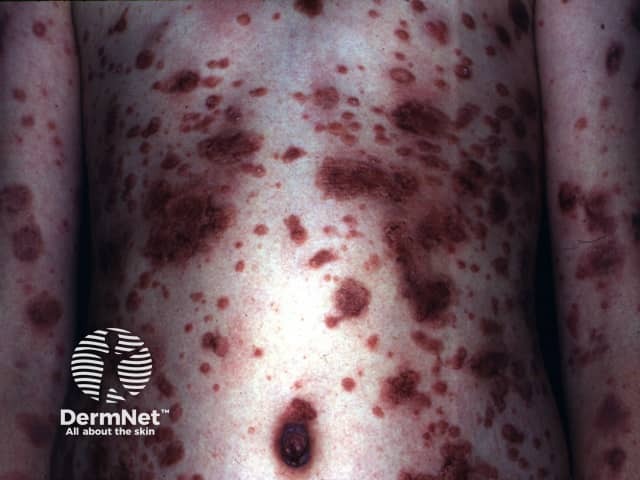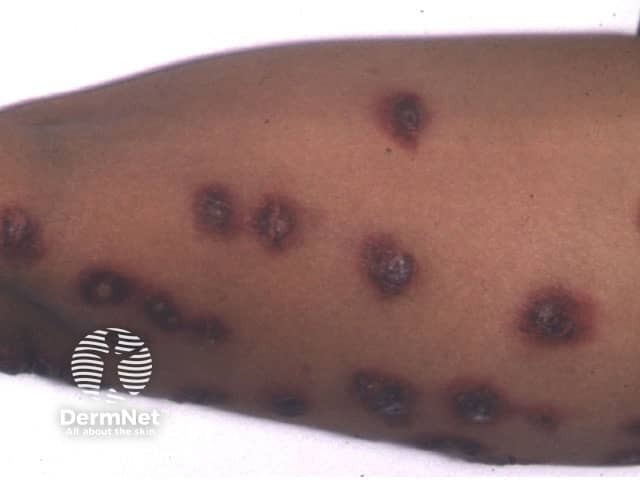Main menu
Common skin conditions

NEWS
Join DermNet PRO
Read more
Quick links
Dithranol — extra information
Method for short contact dithranol treatment How long to continue treatment Staining Precautions Other uses
Although not often prescribed nowadays, dithranol (also called anthralin) is one of the most effective preparations available for treating psoriasis.
In New Zealand, dithranol is available at pharmacies as a 1% cream called Micanol Cream. Consult your dermatologist to see if it's suitable for your skin problem.
Dithranol has to be used carefully because:
- It is irritating, especially if applied to normal skin
- It stains.
The pharmacist can compound it in various different pastes, ointments, and creams, and the strength may vary from 0.1 to 4%. It is most often used in hospitals or day treatment centres.
Dithranol can be effective even if only left on the skin for 10 minutes. This 'short contact' method allows stronger concentrations of dithranol to be used with much less burning and staining. The stronger the dithranol, the better the effect on the psoriasis.
Temporary staining due to dithranol applied to psoriasis



Method for short contact dithranol treatment
A small amount of dithranol should be applied accurately to the psoriasis once or twice a day before a shower or bath. Delicate areas like the face neck , underarm and groin should be treated cautiously, as they are more likely to become irritated. Use a lower strength of dithranol on these sites.
Keep it off normal skin and take care not to touch your eyes. Wash hands after use: it can burn! Keep the dithranol away from clothes and furniture. Avoid exposure to sunlight.
After 10 to 30 minutes the dithranol should be removed. Use cotton wool, soaked in oil or a mild detergent (not soap), and then shower or bathe.
Dithranol can also be applied to the scalp. Comb and wash the hair first and after parting, rub the dithranol into the affected area. Shampoo it off after about 30 minutes. Dithranol is not suitable for blond hair as it stains brown or purple.
How long to continue treatment
Repeat treatment daily until the skin feels entirely clear - that is when there is nothing to feel with the fingers and the texture is normal. Gradually increase the strength of dithranol until it is effective or until the irritation makes it too uncomfortable.
It usually takes six to twelve weeks to achieve clearance.
Staining
The stain from dithranol on the skin is harmless and will gradually disappear after treatment is discontinued. You should not attempt to scrub the colour from your skin. Any staining of the hair will grow out and can be minimised by careful application to the scalp.
Keep dithranol away from fabrics, plastics and other materials. Rinse the bath/shower with lukewarm water immediately after showering; wash the dithranol off, and use a suitable cleaner such as bleach to remove any deposit on the shower/bath surfaces.
Precautions
Don't use dithranol on very sore, angry-looking psoriasis. If treated areas become inflamed, reduce the frequency of application and consult your dermatologist.
Other uses for dithranol
Dithranol has been used to treat alopecia areata. Small non-ramdonised trials have shown variable hair growth when dithranol ointment is applied to the bald areas. It is thought to work by causing an irritant contact dermatitis.
Approved datasheets are the official source of information for medicines, including approved uses, doses, and safety information. Check the individual datasheet in your country for information about medicines.
We suggest you refer to your national drug approval agency such as the Australian Therapeutic Goods Administration (TGA), US Food and Drug Administration (FDA), UK Medicines and Healthcare products regulatory agency (MHRA) / emc, and NZ Medsafe, or a national or state-approved formulary eg, the New Zealand Formulary (NZF) and New Zealand Formulary for Children (NZFC) and the British National Formulary (BNF) and British National Formulary for Children (BNFC).
On DermNet
Other websites
- Consumer medicine information and data sheets — Medsafe
- Drugs, Herbs and Supplements — MedlinePlus
